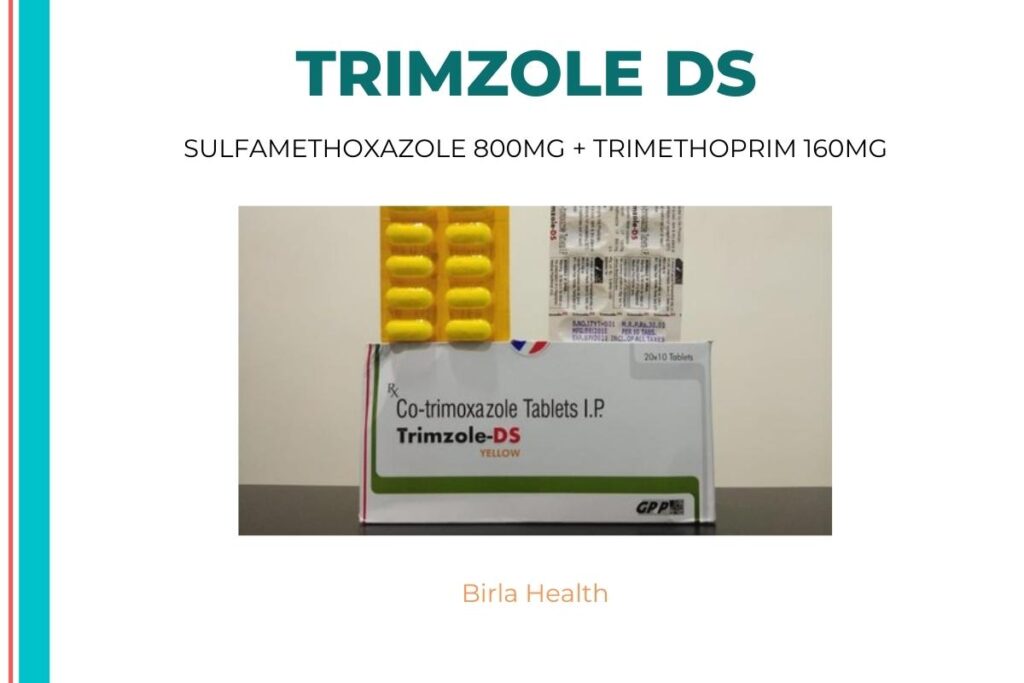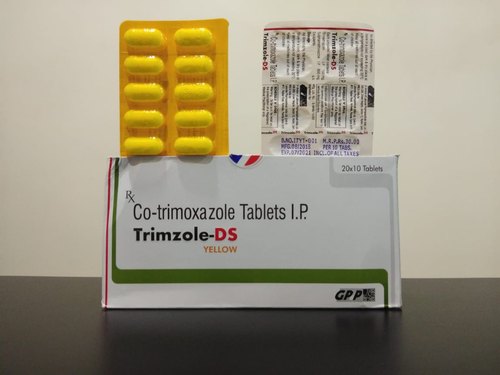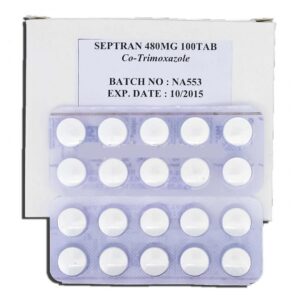TRIMZOLE DS TABLET INFORMATION
Antibiotics, such as TRIMZOLE DS TABLET, are used to treat bacterial infections of the urinary system, respiratory tract (bronchitis), ear (otitis media), lungs (pneumonia), skin, brain, and toxoplasmosis (infection caused by a bacteria called toxoplasma). Bacterial infections are caused by dangerous bacteria multiplying within or on the body. Bacteria that are either infectious or dangerous can make you sick and proliferate swiftly in your body. Toxins are produced by these hazardous bacteria, which can damage tissue and make you sick. TRIMZOLE DS TABLET is ineffective against viral illnesses, such as colds and flu.
Trimethoprim (folic acid inhibitors) and Sulfamethoxazole (antibiotics) are combined as TRIMZOLE DS TABLET (sulfonamides). Trimethoprim prevents the bacteria from producing tetrahydrofolic acid, whereas sulfamethoxazole prevents them from producing dihydrofolic acid. Tetrahydrofolic acid and dihydrofolic acid are required for the production of proteins and nucleic acids, both of which are required for bacterial life. TRIMZOLE DS TABLET destroys germs and prevents their development by blocking these enzymes. As a result, it aids in the treatment of bacterial infections.
To prevent nausea and diarrhea, use TRIMZOLE DS TABLET with food or drink. TRIMZOLE DS TABLET, on the other hand, may be taken with or without meals. Do not crush or chew the tablet form of TRIMZOLE DS TABLET; it should be consumed whole. The liquid version of TRIMZOLE DS TABLET should be taken by mouth with the measuring cup included in the pack; before each use, shake the pack thoroughly. The dose and length of TRIMZOLE DS TABLET will be determined by your medical condition and the severity of your illness. It’s also a good idea to finish the course of treatment even if you feel better since it’s an antibiotic, and skipping it might lead to a more serious illness that won’t react to the antibiotic (antibiotic resistance). High potassium levels in the blood, palpitations (abnormal heartbeats), thrush or candidiasis (fungal infection), headache, nausea, diarrhea, and skin rashes are only a few of the usual adverse effects. The majority of these adverse effects do not necessitate medical treatment and will subside with time. However, if you are experiencing these adverse effects on a regular basis, you should consult your doctor.
If you have an allergy to any antibiotic, or if you have kidney or liver issues, please tell your doctor before starting TRIMZOLE DS TABLET. Self-medication with TRIMZOLE DS TABLET may result in antibiotic resistance, in which medications cease to work against certain bacterial illnesses. If you are pregnant or nursing, talk to your doctor before using TRIMZOLE DS TABLET. To avoid unpleasant side effects such as racing heartbeats, warmth or redness under your skin, tingling sensations, nausea, and vomiting, avoid consuming alcohol. Children under the age of 12 should not be given TRIMZOLE DS TABLET. To rule out any unpleasant side effects, keep your doctor informed about all the drugs you’re taking and your health state.
Bacterial infections are treated with TRIMZOLE DS TABLET.

Medicinal Advantages
Antibiotics, such as TRIMZOLE DS TABLET, are used to treat bacterial infections of the urinary system, respiratory tract (bronchitis), ear (otitis media), lungs (pneumonia), skin, brain, and toxoplasmosis (infection caused by a bacteria called toxoplasma). Trimethoprim (folic acid inhibitors) and Sulfamethoxazole (antibiotics) are combined as TRIMZOLE DS TABLET (sulfonamides). Trimethoprim prevents the bacteria from producing tetrahydrofolic acid, whereas sulfamethoxazole prevents them from producing dihydrofolic acid. Tetrahydrofolic acid and dihydrofolic acid are required for the production of proteins and nucleic acids, both of which are required for bacterial life. TRIMZOLE DS TABLET destroys germs and prevents their development by blocking these enzymes. As a result, it aids in the treatment of bacterial infections. TRIMZOLE DS TABLET is a broad-spectrum antibiotic that works against a variety of gram-positive and gram-negative bacteria, including Streptococcus pneumoniae, E. coli, Klebsiella species, Enterobacter species, Haemophilus influenzae, and others.
Use Instructions
To prevent nausea and diarrhea, use TRIMZOLE DS TABLET with food or drink. TRIMZOLE DS TABLET, on the other hand, may be taken with or without meals. Do not crush or chew the tablet form of TRIMZOLE DS TABLET; it should be consumed whole. The liquid version of TRIMZOLE DS TABLET should be taken by mouth with the measuring cup included in the pack; before each use, shake the pack thoroughly. The dose and length of TRIMZOLE DS TABLET will be determined by your medical condition and the severity of your illness.
Storage
Store in a cool, dry location away from direct sunlight.
TRIMZOLE DS TABLET Side Effects
TRIMZOLE DS TABLET, like other drugs, can produce adverse effects, though not everyone gets them. The most frequent adverse effects of TRIMZOLE DS TABLET include high potassium levels in the blood, palpitations (abnormal heartbeats), thrush or candidiasis (fungal infection), headache, nausea, diarrhoea, and skin rashes. If you encounter any of these adverse effects on a regular basis, please see your doctor.
Drug Recommendations
If you are allergic to any of the ingredients in SULFAMETHOXAZOLE + TRIMETHOPRIM, or if you have severe liver or kidney issues, thrombocytopenia (low platelet counts in the blood), or porphyria, don’t take it (rare blood problem that affects skin or nervous system). Self-medication with SULFAMETHOXAZOLE + TRIMETHOPRIM may result in antibiotic resistance, in which medications cease to work against particular bacterial illnesses. If you develop a skin rash or suffer persistent, severe diarrhoea with stomach aches, see your doctor right once. If you have severe allergies, asthma, ulcers, blood disorders, thyroid dysfunction, diabetes, are elderly, underweight, or malnourished; if you have a folic acid deficiency, glucose-6-phosphate dehydrogenase deficiency, or high potassium levels in the blood, consult your doctor before taking SULFAMETHOXAZOLE + TRIMETHOPRIM. If you’re pregnant or nursing, don’t take SULFAMETHOXAZOLE + TRIMETHOPRIM unless your doctor tells you to. To avoid unpleasant side effects including fast heartbeats, warmth or redness beneath your skin, tingling feeling, nausea, and vomiting, avoid drinking alcohol while taking SULFAMETHOXAZOLE + TRIMETHOPRIM.
Interactions Between Drugs
SULFAMETHOXAZOLE + TRIMETHOPRIM may interact with sulphonylureas (gliclazide, glibenclamide), thiazide diuretics (bendroflumethiazide), antibiotics (azithromycin, metronidazole), and bronchodilators (azithromycin, metronidazole), as well as other drugs (albuterol).
Avoid drinking alcohol while taking SULFAMETHOXAZOLE + TRIMETHOPRIM to avoid unpleasant side effects including racing heart, warmth or redness beneath your skin, tingling sensations, nausea, and vomiting.
Interactions with other drugs and diseases: SULFAMETHOXAZOLE + TRIMETHOPRIM may interact with colitis (inflammation of the colon lining), hematologic (blood) toxicity, hypersensitivity reactions, porphyria (rare blood disorder affecting the skin or nervous system), folate deficiency, crystalluria (cloudy urine), dialysis, urinary obstruction, kidney and liver dysfunction.
Safety Suggestions
ALCOHOL
To avoid unpleasant side effects including fast heartbeats, warmth or redness beneath your skin, tingling feeling, nausea, and vomiting, avoid drinking alcohol while taking SULFAMETHOXAZOLE + TRIMETHOPRIM.
PREGNANCY
If you’re pregnant, don’t use SULFAMETHOXAZOLE + TRIMETHOPRIM unless your doctor tells you to since it might cause birth problems. If you are pregnant, talk to your doctor before taking SULFAMETHOXAZOLE + TRIMETHOPRIM. Only if the advantages exceed the dangers will your doctor prescribe SULFAMETHOXAZOLE + TRIMETHOPRIM.
BREAST FEEDING
Breast milk may include SULFAMETHOXAZOLE + TRIMETHOPRIM. If you’re nursing, talk to your doctor; SULFAMETHOXAZOLE + TRIMETHOPRIM will only be prescribed if the advantages outweigh the hazards.
DRIVING
It is uncertain if SULFAMETHOXAZOLE + TRIMETHOPRIM has an effect on your ability to drive or operate machinery. After taking SULFAMETHOXAZOLE + TRIMETHOPRIM, you should not drive or operate any equipment or vehicles unless you are physically stable and mentally concentrated. If you suffer dizziness or weariness, you should not drive or operate any machinery or vehicles.
LIVER
If you have liver impairment or illness, talk to your doctor before using SULFAMETHOXAZOLE + TRIMETHOPRIM. Before prescribing it to you, your doctor will consider the advantages as well as any possible hazards.
KIDNEY
SULFAMETHOXAZOLE + TRIMETHOPRIM should be used with care, particularly if you have a history of renal illness or impairment. Your doctor may need to modify the dosage.
No habit formation
Advice on Diet and Lifestyle
Antibiotics have the potential to change the beneficial bacteria in the stomach that aid digestion. As a result, foods high in probiotics, such as yoghurt/curd, kefir, sauerkraut, tempeh, kimchi, miso, kombucha, buttermilk, natto, and cheese, are recommended.
Whole grains, beans, lentils, berries, broccoli, peas, and bananas are all high in fiber.
Calcium-rich meals, grapefruit, and grapefruit juice should be avoided since they may interfere with antibiotic absorption.
To properly cure your disease, avoid consuming alcohol.
Tobacco should be avoided.
Even if you have symptomatic alleviation, finish the full course of SULFAMETHOXAZOLE + TRIMETHOPRIM to effectively treat your illness.
Recommendations
Certain laboratory test results, such as blood tests, may be affected by SULFAMETHOXAZOLE + TRIMETHOPRIM. Tell the person who is doing the tests that you are taking SULFAMETHOXAZOLE + TRIMETHOPRIM.
If you have kidney difficulties or have been taken SULFAMETHOXAZOLE + TRIMETHOPRIM for a longer period of time, your doctor may suggest you to undergo frequent testing to see if the drug is functioning well.
Additional Information : This item is non-refundable.
Glossary of Diseases and Conditions
Bacterial infections are illnesses caused by dangerous bacteria that enter, grow, and infect our bodies. Bacteria that are either infectious or dangerous can make you sick and proliferate swiftly in your body. Toxins are produced by these hazardous bacteria, which can damage tissue and make you sick. It may attack any region of the body and multiply swiftly. When bacteria infects you, you may have nonspecific symptoms such as fevers, chills, and exhaustion. Bacteria come in a variety of shapes, the most common of which are spherical, rod-shaped, and spiral-shaped. Bacterial infections range from simple ailments such as sore throats and ear infections to serious diseases such as meningitis and encephalitis. A bacterial illness can affect anyone at any time. People with weakened immune systems or those using immunosuppressive medications, on the other hand, are more susceptible to bacterial infection.
FAQs
Trimethoprim (folic acid inhibitors) and Sulfamethoxazole (antibiotics) are combined in SULFAMETHOXAZOLE + TRIMETHOPRIM (sulfonamides). Trimethoprim prevents the bacteria from producing tetrahydrofolic acid, whereas sulfamethoxazole prevents them from producing dihydrofolic acid. Tetrahydrofolic acid and dihydrofolic acid are required for the production of proteins and nucleic acids, both of which are required for bacterial life. SULFAMETHOXAZOLE + TRIMETHOPRIM destroys germs and prevents their development by blocking these enzymes. As a result, it aids in the treatment of bacterial infections.
Thrush or candidiasis is a fungal infection caused by an excess of yeast-like fungus in the mouth or throat. SULFAMETHOXAZOLE + TRIMETHOPRIM causes thrush or candidiasis. Rinse your mouth with water on a regular basis to keep fungus at bay.
SULFAMETHOXAZOLE + TRIMETHOPRIM may cause diarrhea as a negative effect. If you have diarrhea, drink plenty of water and consume plenty of fiber-rich foods. Stop using SULFAMETHOXAZOLE + TRIMETHOPRIM and visit your doctor if you notice blood in your stools (tarry stools) or if you have persistent diarrhea with stomach discomfort. Do not self-medicate with anti-diarrheal medication.
Even if you feel better, it’s best to finish the course of SULFAMETHOXAZOLE + TRIMETHOPRIM since it’s an antibiotic and skipping doses might lead to recurrent infections. Continue to take SULFAMETHOXAZOLE + TRIMETHOPRIM for as long as your doctor recommends to effectively treat your condition.
To avoid unpleasant side effects including fast heartbeats, warmth or redness beneath your skin, tingling feeling, nausea, and vomiting, avoid drinking alcohol while taking SULFAMETHOXAZOLE + TRIMETHOPRIM.
Self-medication with SULFAMETHOXAZOLE + TRIMETHOPRIM may result in antibiotic resistance, in which medications cease to work against particular bacterial illnesses.
Certain laboratory test results may be affected by SULFAMETHOXAZOLE + TRIMETHOPRIM. Tell the person who is administering the tests that you are taking TRIMZOLE DS TABLET.
TRIMZOLE DS TABLET may produce excessive potassium levels in the blood, which can cause irregular heartbeats (palpitations). While using TRIMZOLE DS TABLET, it is recommended that potassium levels and heart rate be monitored on a regular basis.








Leave a Reply
You must be logged in to post a comment.